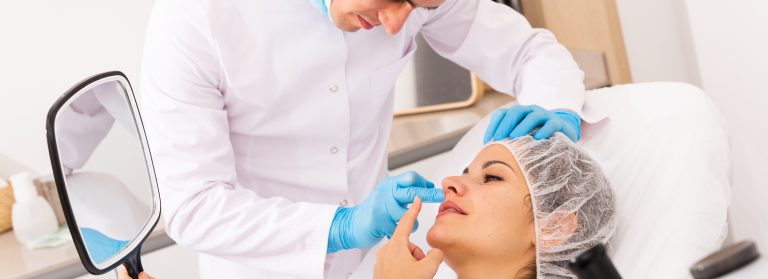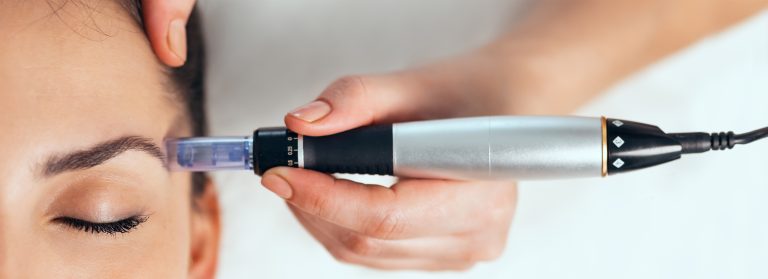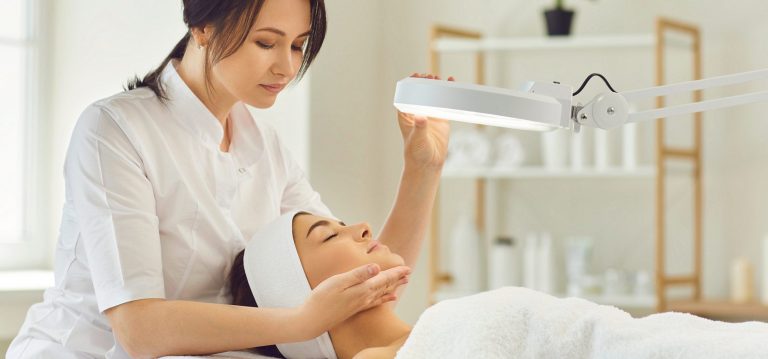What is Microneedling
Microneedling is a minimally invasive cosmetic procedure whereby fine sterile needles puncture the skin repeatedly at high speed to induce collagen production. Research is ongoing for this technique. Also referred to as collagen induction therapy, the skin responds to the small skin injuries by producing new collagen-rich tissue. Microneedling provides results soon after treatment. It is minimally invasive and requires short downtime.
It is used for the purposes of skin rejuvenation to assist with anti-ageing and skin concerns such as acne, scars and stretch marks. Microneedling can help with reducing the appearance of fine lines and wrinkles.
It is useful to learn more about microneedling and discuss it with your skin clinic to determine whether it is the right option for you.
Is It for You?
Microneedling can be effective for individuals interested in boosting collagen for younger-looking skin or to reduce wrinkles, large pores and the visibility of certain types of scars.
You may be an ideal candidate for this procedure if you’re in good health and have certain skin concerns that haven’t responded to home treatments or other types of dermatologic procedures, such as peels.
How It Works?
Microneedling treatments attempt to boost your skin to produce more collagen. Collagen is required for youthful-looking skin. It naturally declines over time due to age, lifestyle, sun exposure and other factors.
The microneedles wound the skin causing collagen production even though the wounds are minuscule. Each tiny wound goes through skin healing in three phases:
- Inflammation
- Proliferation (tissue formation)
- Tissue rejuvenation
The skin develops new tissue that results in an evener skin texture and tone. It looks plump, radiant and luminous for a few weeks.
Microneedling or At-Home Rollers?
Microneedling is considered to be a professional procedure that should only be conducted by a qualified practitioner. A specific device is used that requires training and experience.
Rollers can be done at home however they do not puncture the skin as effectively as professional microneedling. It is unlikely to achieve the same results for skin rejuvenation.
Skin Areas
The treatment is mostly applied to the face area to address the following concerns:
- Fine lines and wrinkles
- Dull and tired skin
- Uneven skin tone
- Low skin elasticity
- Large pores
- Some types of sunspots and age spots
- Some types of acne and other scars
Microneedling can also be applied to some areas of the body. It can be used to treat stretch marks on the arms, thighs and tummy areas. Similarly, scars on the body can also be treated with this procedure.
Microneedling is often used in combination with other treatments to improve the effectiveness of the results. The skill and experience of the practitioner and the quality of the device they use also influences the results.
The Treatment
The skin professional will assess your skin and prepare it for treatment. Care should be taken to thoroughly cleanse your skin with reputable products. A topical anaesthetic is applied to lower the chances of pain and discomfort. It is left on the skin for a while to take effect.
Your practitioner will commence microneedling with the device using a particular technique to cover the area of treatment. A test area should be done to see how your skin responds. Following which they will cover the entire area.
Depending on the needle depth used, it is fairly common for bleeding to occur.
After completion of the procedure, the practitioner should provide you with aftercare information and recommend products to aid the healing of your skin for optimal results.
Risks
Microneedling has risks like all cosmetic procedures and should only be performed by a qualified practitioner. There can be skin irritation from the treatment. The redness should be temporary. Contact your skin professional if you have any concerns about side effects.
Some instances where microneedling is not suitable if you are:
- Pregnant
- Have active acne
- Have a history of keloids and skin scarring
- Undergoing medical treatments such as radiation therapy
- Have certain skin diseases such as eczema or psoriasis
- Have injuries and open wounds
- Taking prescription medications where microneedling is not recommended
- Experiencing an active skin infection
- Subject to an unstable skin type
Some side effects after the procedure:
- Redness and slight discomfort
- Flaking and dryness
- Bruising
- Swelling
Microneedling is not for individuals prone to bleeding disorders and blood-related medical conditions. It is important to always consult your doctor before booking any treatments.
There is also a risk of infection or a reaction to the topical products used.
The type of device used is a source of possible additional risks.
Consult your doctor to determine whether microneedling is appropriate for you based on your health and medical history.
Pre-Treatment Preparations
Your practitioner will inform you about preparing your skin for the treatment ahead of the appointment. It is necessary to ensure optimal benefits from the procedure and to minimise side effects and risks. One might have to stop certain medications and skin care products well in advance of the procedure.
Post Treatment Expectations
Recovery time and downtime are minimal. There can be minor skin irritation and redness following the treatment. This is usually a natural skin response as part of the rejuvenation process.
If you wear make-up, ask your practitioner about when to apply it after treatment.
Your skin will be more sensitive to the sun. It is important to protect your skin with a broad spectrum SPF sunscreen to shield against UVA and UVB rays.
The skin rejuvenates with new tissue relatively quickly post microneedling. Results can be seen within a few days. Multiple sessions are required to improve and maintain the results. Generally, six procedures usually four to six weeks apart can help to see the improvements and more youthful skin.
There are many complementary treatments that can be combined with microneedling to enhance the effects. Your skin professional will advise you on the best treatment plan for your skin and individual goals.






